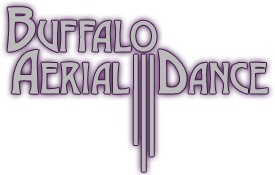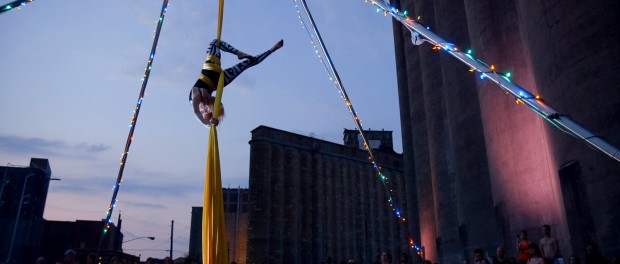Sparking your Motivation: Student Showcases and Aerial Goal Setting
For many starry-eyed newbies, part of the allure of aerial arts is the potential to share your newfound skills with friends, family, and perhaps eventually larger audiences. Other budding aerialists prefer to keep their training more private and personal for quite sometime and maybe indefinitely. For those of you who do want to take center stage, you were probably excited to find there’s a few relatively easy aerial poses that look gorgeous and make you feel like a superstar right away. The other 97% of poses get progressively more challenging, but nevertheless, the dreaming has already begun. If you’re dreaming of your name in lights, I’m certainly not going to stop you, but I will encourage you to plan your steps and draw an honest path from goals to accomplishment.
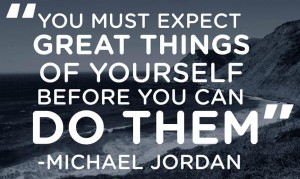 OK, step 1, come to class for at least a couple months Step 2, when you feel ready and when your instructor gives you the green light, sign up for a student showcase. Showcases are great because they offer a ready-made avenue from goal to accomplishment: practicing a certain sequence of moves until you can do them with good technique and a little added style. Good technique is a part of your goal, right?!? And sure, part B of that goal might be to wear a fancy costume, show off for your friends, and do your own interpretation of that song you play on repeat. You’re totally entitled to have fun with it. If you like fun, the comradery among the student performers during the showcase makes the experience even better. Being backstage and sharing in the anticipation with other artists is kinda my favorite part of shows.
OK, step 1, come to class for at least a couple months Step 2, when you feel ready and when your instructor gives you the green light, sign up for a student showcase. Showcases are great because they offer a ready-made avenue from goal to accomplishment: practicing a certain sequence of moves until you can do them with good technique and a little added style. Good technique is a part of your goal, right?!? And sure, part B of that goal might be to wear a fancy costume, show off for your friends, and do your own interpretation of that song you play on repeat. You’re totally entitled to have fun with it. If you like fun, the comradery among the student performers during the showcase makes the experience even better. Being backstage and sharing in the anticipation with other artists is kinda my favorite part of shows.
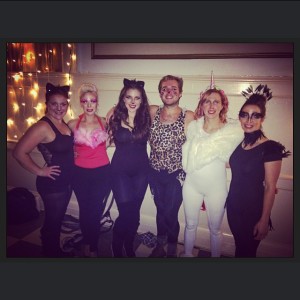
The whole menagerie, at Imperial Court of Buffalo 2016
After 11 years of this stuff, I still find that an upcoming performance usually motivates me to polish a few skills I’ve been slacking on, but, I’ve also been lucky enough to have a little bit of that motivation come in the form of cash money (by the way, financial gain is a really terrible goal to have in the performing arts). And sometimes, even with a big show, creativity and motivation are just not happening – or there’s no shows to be had. One drawback to performing is that we can get caught up in the pizzazz and overlook other ways of finding motivation and pure joy in what we do. I have lots of respect for students who aren’t too interested in performing, yet continue to train day in and day out. Sharing a training environment with such people puts me in a really good headspace where I find myself working on some of the following:
Aerial drills – There are plenty of drills that are actual moves to be used in choreography – single arm hangs, elbow hangs, toe hangs, various beats – but when I practice these as drills, choreography is usually the last thing on my mind. I enjoy the simplicity of focusing on the drill as an end in itself.
Spinning and heights – Sometimes all it takes to spark newness in an old move is to change the dynamics or setup. I’m totally comfortable lazing around in back balance maybe 10 feet up, but higher than that and it gets my adrenaline going a little bit. When I’m working on a newer or harder move, sometimes I’ll set a goal of doing it 1 or 2 feet higher each week. Same thing with adding spin; starting with a slow spin and adding speed can be a great way to make easier moves and transitions more challenging with just a little twist (ha!).
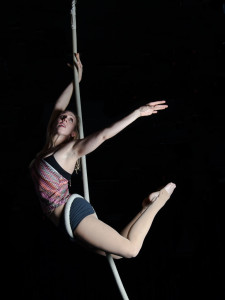
Photo by Sarah Westphal
Grace and expressiveness – I work on being expressive separately from being graceful. To me, grace is about a particular aesthetic that is a useful, and highly technical, expressive tool. Expressiveness is about exploring a range of styles, some of which might be based on specific techniques, but others are idiosyncratic. Working on these elements isn’t a straightforward path to progress, it’s an exploration without any particular structure or time frame. There can be guidance, but it’s highly personal and requires getting comfortable with yourself.
Make up your own move – If you’re feeling up to a mental challenge, or just want some aerial street cred, try putting yourself up to the task of creating a new move. This is often intertwined with the point below (just play) but it can be more intentional as well. Once you’ve got the fundamentals and some aerial theory down, start to break a rule or two and see what you find. A lot of new moves come from methodical experimentation.
Just play – This is another sort of mental challenge where you have to talk yourself out of repeating your training verbatim and talk yourself into taking some chances, and letting go. Of course those chances should be calculated risks, low to the ground, with mats, etc. This can lead to new moves without that necessarily being the end-game. My favorite is when it leads to new shapes and ways of moving within existing moves, and blurring the lines a bit.
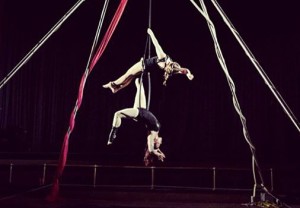 Duo goals – I’ve found that aerialists tend to be busy, independent-minded people and it’s often most convenient to work individually, but sometimes lone wolves get lonely. There’s a lot of joy in working with a partner, and you’d be surprised at both how tricky it is and how awesome it looks to synchronize aerial moves. Plus there’s that whole building trust with another aerialist, and tons of silliness and laughter too.
Duo goals – I’ve found that aerialists tend to be busy, independent-minded people and it’s often most convenient to work individually, but sometimes lone wolves get lonely. There’s a lot of joy in working with a partner, and you’d be surprised at both how tricky it is and how awesome it looks to synchronize aerial moves. Plus there’s that whole building trust with another aerialist, and tons of silliness and laughter too.
Being in the club –Sometimes what motivates me is simply being in an environment where all of the above is happening. It’s beautiful and magical, and I feel fortune to be in the presence of other humans who are developing their strength, creativity and general badass-ness. It creates a sense of duty to contribute to that environment by doing the same.
Working any or all of the above, whether performance-related or not, is what we call “loving the process.” It’s a part of an aerial education and experience, not just trying to get through an exam. But if an “exam” or big opportunity comes up, consistent training prepares you like nothing else can. Buffalo isn’t Broadway, but we get some good gigs. I’ve found it a great place to strike a balance between the opportunity to develop a few marketable acts and the opportunity to take time to dig into weirder stuff for creative satisfaction. I love creating space for students to grow into these roles as well.
